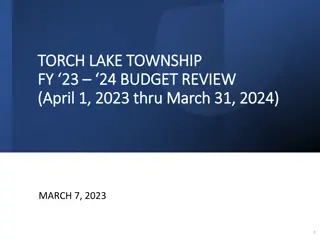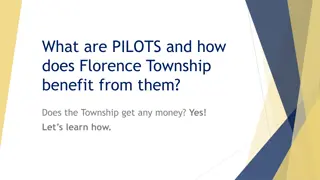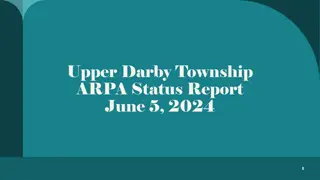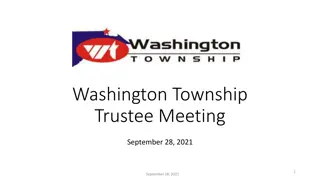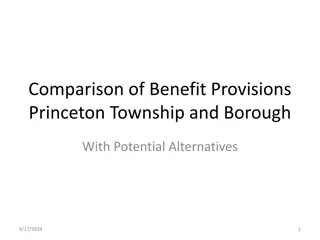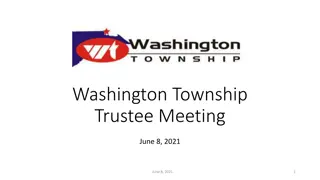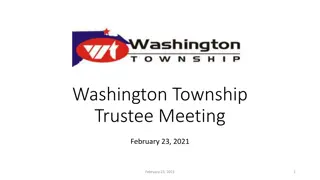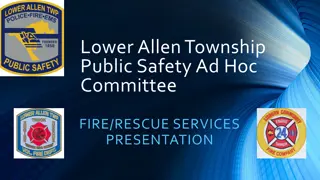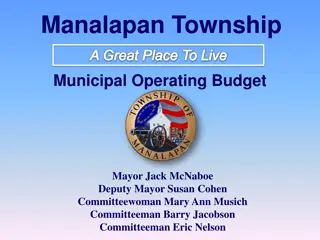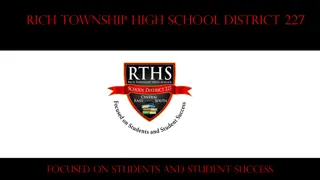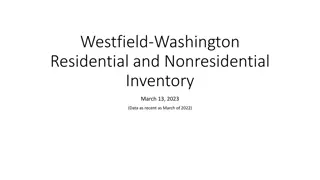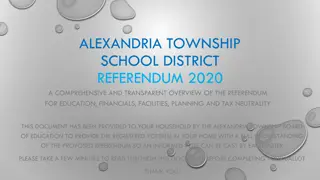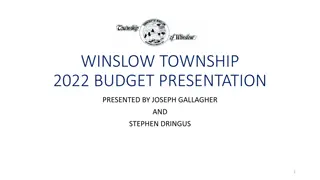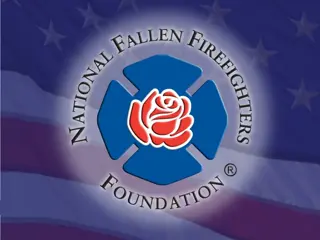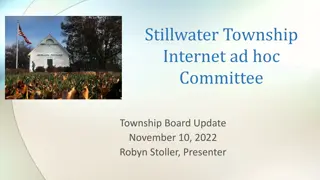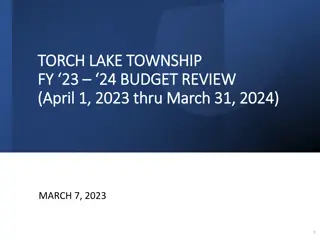Developing a Strategic Vision for Lower Allen Township Public Safety
Lower Allen Township Public Safety Ad Hoc Committee is focusing on developing a strategic vision for the next 5-10 years. The committee will consider areas such as staffing, training, equipment, technologies, facilities, and regional solutions. Public Safety Technologies aim to enhance personnel efficiency and cost-effectiveness through equipment and software while exploring future considerations for police and fire departments.
Download Presentation

Please find below an Image/Link to download the presentation.
The content on the website is provided AS IS for your information and personal use only. It may not be sold, licensed, or shared on other websites without obtaining consent from the author.If you encounter any issues during the download, it is possible that the publisher has removed the file from their server.
You are allowed to download the files provided on this website for personal or commercial use, subject to the condition that they are used lawfully. All files are the property of their respective owners.
The content on the website is provided AS IS for your information and personal use only. It may not be sold, licensed, or shared on other websites without obtaining consent from the author.
E N D
Presentation Transcript
Lower Allen Township Public Safety Ad Hoc Committee DEVELOPING A STRATEGIC VISION FOR THE NEXT 5-10 YEARS
Welcome! DIRECTOR HOLL
Original Scope of Proposed Topic areas to be considered by the Public Safety Ad Hoc Committee for all discipline s recommendations: Staffing (Critical Component) Training Equipment Technologies Facilities (Funding of Consulting Study 2020?) Regional Solutions and Partnerships?
Public Safety Technologies EQUIPMENT AND SOFTWARE THAT ADDS VALUE TO PERSONNEL PERFORMING THEIR JOB RESPONSIBILITIES IN A MORE EFFICIENT AND COST-EFFECTIVE MANNER.
Public Safety Technologies POLICE Cody Records Management System Used for crime and incident management reporting The foundation of police incident reporting and analysis CAD ( 911 Computer Aided Dispatch) xMobile (county moving to Hexagon CAD and mobile by August 2020) Provides for mobile dispatch and CAD to car communication Police can also access Alpine Fire software for pre-plans and incident information LPR (License Plate Readers stationary system currently installed) Used in investigations and feedback on expired registrations and wanted vehicles
POLICE - Future considerations: Body CAMS with fully integrated Wi-Fi to car video systems https://watchguardvideo.com/body-cameras/vista-wifi As the public scrutiny of police increases and false claims are reported, it may become imperative for officers to document the validity of their behavior. CrimeEye public area surveillance cameras Adds to the ability to provide behavior observation for investigation and crime prevention in high risk targeted zones. LPR System expansion to additional sites and mobile units Other Mission specific applications TBD as evolved GIS Mapping and analysis capabilities Allows for the analysis of trends and better deployment of resources.
Public Safety Technologies FIRE Alpine RedNMX Used for fire incident reporting Used for monitoring calls for service and statuses Used with a mobile App for call alerting and incident inf0rmation Used for Fire preplans and inventory Supports Codes Property Maintenance and Fire Inspection Program CAD MobileResponder (county moving to Hexagon CAD and mobile by August 2020) Future considerations: GIS Mapping and analysis capabilities
Public Safety Technologies EMS ESO Patient Care Reporting (PCR) Data Analysis Performance Improvement Revenue Recovery CAD MobileResponder (county moving to Hexagon CAD and mobile by August 2020) EMS can also access Alpine Fire software for pre-plans and incident information Future considerations: GIS Mapping and analysis capabilities Video Communication with Medical Direction
Review of Public Safety Disciplines Staffing Presentations
Planned Development Projections The population increase per year is extrapolated, giving a predicted population of approximately 19,253 in 2021.
Staffing History vs. Dispatched Calls 1995-Present (Includes 2018) Staffing (18% increase since 1995) 1995 -18 2017 22 Low 17 in 2000 High 22 in 2018 Dispatched Calls (229% increase since 1995) 1995 5300 (low) 2018 17448 (high)
IACP Ideal Ratio The IACP (International Association of Chiefs of Police) recommends that 1/3 of an officer s time be spent on responding to and handling calls for service or other obligated duties. The remaining 2/3 should be dedicated to administrative activities and proactive duties. Thus, in accordance with industry standards, we should have 20 minutes per hours in obligated time, 40 minutes unobligated.
2021 Ratio With 2018 Staffing 2 Officer Minimum Staffing per Shift, 3 Officer Most Frequent Level, 4 Officer Full Staff
2021 Planned Staffing Goal (20 Patrol Officers) 3 Officer Minimum per Shift 5 Officer Full Shift
What does this mean for the future? If we continued to maintain 2018 staffing (2 officer minimum, 4 officer squads), in 2021 probability of saturation (POS) will be: With the recommended 5- officer squads with a 3-officer minimum: 4.3% POS 36% of the time 13.4% POS 40% of the time 87.2% POS 21% of the time. 36.6% POS 21% of the time 36.6% POS 40% of the time. 87.2% NEVER this bad. 13.4% POS 36% of the time 4.3% NEVER this good.
What level of capability do we need to be prepared for? What level of service? Insurance Services Organization (ISO) requirements Fire Suppression Rating Schedule - 2012 Senate Resolution 6 Commission Report 2018 Standard of Cover NFPA 1710 Standard and Deployment of Fire Suppression Operations, Emergency Medical Operations, and Special Operations to the Public by Career Fire Departments NFPA 1720 Standard and Deployment of Fire Suppression Operations, Emergency Medical Operations, and Special Operations to the Public by Volunteer Fire Departments NFPA 1730 Standard and Deployment of Fire Prevention Inspection and Code Enforcement, Plan Review, Investigation, and Public Education Operations
What level of capability do we need to be prepared for? (Source PA Senate SR-6) Offensive Service Level 1 Personnel Required -15 Equipment -2 NFPA criteria engine (pumper), and one truck company (aerial or support truck) Interior and Exterior Firefighting capabilities of both residential and commercial buildings. Vehicle rescue capabilities with power or no power equipment and provide Operations level Hazardous Materials Response. NFPA PPE/SCBA for each person. Expectations -Ability to extinguish a fire and save life and property. The ability to perform and extricate a person from a motor vehicle efficiently. The ability to identify and provide operations level hazardous materials response. Arrive on scene within 9 minutes of dispatch, 90 percent of the time.
What level of capability do we need to be prepared for? (Source PA Senate SR-6) Offensive Service Level 2 Personnel required - 10 Equipment -2 NFPA criteria engine (pumper) Interior Firefighting capabilities of room or contents and small buildings under 10,000 square feet. Vehicle rescue capabilities with power or no power equipment and provide Operations level Hazardous Materials Response. NFPA PPE/SCBA. Expectations -Ability to extinguish a fire and save life and property. The ability to perform and extricate a person from a motor vehicle efficiently. The ability to identify and provide operations level hazardous materials response. Arrive on scene within 10 minutes of dispatch, 80 percent of the time.
What level of capability do we need to be prepared for? (Source PA Senate SR-6) Offensive Service Level 3 Personnel required 6 Equipment -One NFPA criteria engine (pumper) Interior Firefighting capabilities only of room or contents and small buildings under 5,000 square feet. Also, vehicle extrication capabilities with little or no power equipment. NFPA PPE/SCBA. Expectations -Ability to extinguish a fire and save life and property. The ability to extricate a person from a motor vehicle efficiently. Respond within 9 minutes, plus travel time.
What level of capability do we need to be prepared for? (Source PA Senate SR-6) Offensive Service Level 4 Personnel required 4 Equipment One NFPA criteria engine (pumper) Exterior Defensive Firefighting capabilities only Expectations Protect surrounding exposures, loss of involved property NO TIME LIMITS
Lower Allen Fire Company Staffing and Age 40 37.6 37.1 34.7 34.5 33.7 35 30 24 25 22 21 20 20 17 15 10 5 0 2014 2015 2016 2017 2018
Lower Allen Fire Day / Night Average Staffing Responders on Scene What are our current capabilities? 5.4 5.4 5.2 4.6 4.3 3.6 2017 2018 2019 DAY NIGHT
Lisburn Fire Co Calls and Staffing per Year 250 16 What are our current capabilities? 14 200 12 10 150 8 100 6 4 50 2 0 0 2006 2007 2008 2009 2010 2011 2012 2013 2014 2015 2016 2017 2018 Total Calls # FF > 50% # FF > 25% # Vol FF > 25% # FF > 10% # Vol FF > 10%
EMS Past to Present EMS Requests for Service Increased 63% between 2001-2018 3500 3000 2500 EMS Request for Service 2000 1500 1000 500 0 EMS Request for Service in 2001 EMS Request for Service in 2018
Call Volume Trends 2015 to 2019 2015 2940 2016 2970 2017 3151 January 1, 2019 to June 30, 2019 1866 Calls 54% of the volume for 2018 2018 3490 2019 1866
Call Volume Trends 2015-2018 18.7% Increase 3600 3500 3400 3300 3200 3100 3000 2900 2800 2700 2600 2015 2016 2017 2018
Township Factors Causing Increases EMS calls increased 17.98% 2015 to 2018 Population increased 5.16% 2015 to 2018 Arcona is a population increase (3000+) within 10-20 years Commercial Development State Prison Increased highway traffic congestion Rt.15, I-83, Rt.581 What is the impact for EMS? +Increased Demands for Service with +Increased Call Volume
The Boomers Looking to the future 28% of the population Ages 54-72 10,000 Baby Boomers reach retirement age daily until 2030 Americans 65 and older will double from 46 million today to over 98 million by 2060 Nursing home care, 1.3 million in 2010 estimated to be 2.3 million in 2030
EMS Unavailable to Provide Service Impacts 2018 389 missed responses 2019 January 1 to May 31 253 missed responses Will exceed 2018 totals at the current rate with current staffing and deployment strategy
Levels of Service (LOS) CRITERIA FOR PUBLIC SAFETY DISCIPLINES
Level of Service and Factors Affecting LOS Highway Definition: LOS is a scale which defines the operating conditions on highways. It is a measure of the restrictive effects of the increased volume, level of service as proposed by manual ranges from A to F where A is ideal level and F is worst level of service. Fiscal impact is always a consideration of LOS in terms of SAFETY and Acceptability. Applicability to Public Safety LOS can be applied to Public Safety Services as well. Increased volume in calls for service is a measures of decreases in response time to provide critical emergency services in a timely manner. It can be viewed as a how long do you want to wait factor ? (WF) What is acceptable to police, fire, or EMS responses?
POLICE LOS Levels A-F (Refer to Handout for Narratives) A = Ideal ratio of 1/3 obligated time, 2/3 unobligated time maintained or exceeded 24/7, 365. B = Able to maintain ideal ratio of 1/3 obligated time, 2/3 unobligated when at full staffing. C = Able to maintain less-than-ideal ratio of 1/2 obligated time, 1/2 unobligated when at full staffing. D = Unobligated time routinely less than 1/3 of total time. E = Negative on unobligated time. F = Negative on unobligated time.
POLICE LOS Chart POLICE Levels of Service Staffing Chart B 24 26 27 28 29 29 29 29 29 A C D 18 20 21 22 23 23 23 23 23 E** 14 16 17 18 19 19 19 19 19 F** 10 12 13 14 15 15 15 15 15 2016 2019 2020 2021 2022 2023 2024 2025 2026 28 30 32 34 35 35 35 35 35 22 24 25 26* 27 27 27 27 27 2021 Breakdown A B C D 16 E F Patrol CI SRO Command Flex Total 24 4 22 4 20 14 2 10 2 3 3 1 3 2 1 3 2 3 3 2 2 34 32 26 22 18 14 * Current recommendation proposed to the Board from the 2018 study
POLICE DEPARTMENT GOAL 5-patrol officers per platoon by 2021 to maintain LOS C. This is achieved by adding 1 officer in 2020 and 1 in 2021 to cover the increased demand for services that currently exist. LOS C is then maintained until 2026depending upon real experience as Arcona and other development projects proceed. Beginning in 2022 the prognosis becomes more dismal with level of service possibly dropping to LOS D by 2026 if additional officers are not added.
FIRE LOS Levels A-F (Refer to Handout for Narratives) A = NFPA 1710 Career Fire Department (High Hazard Occupancy Interior Firefighting Response) B = NFPA 1710 Career Fire Department (Apartment/Strip Mall Occupancy Interior Firefighting Response) C = NFPA 1720 Combination/Volunteer Fire Department (Residential and Commercial Occupancy Interior Firefighting Response) (Meets current ISO requirements) D = All Volunteer Fire Department (Residential/Small Commercial Occupancy Interior Firefighting Response) (Possible increase in ISO rating) E = All Volunteer Fire Department (Residential Occupancy Interior Firefighting Response) (Small Fire involving Room and Contents) (Increase in ISO Rating) F = All Volunteer Fire Department (Exterior Firefighting Response) (Protection of Exposures and Loss of Fire Building) (Increase in ISO Rating)
FIRE LOS Chart NFPA Standard 1710 2016 Edition Operating Unit Staffing Minimum High # of Incidents High Hazard Occupancies Supervisory Chief 2 (Chief Officer and Aide) 2 (Chief Officer and Aide) 2 (Chief Officer and Aide) Engine Company 4 on-duty personnel 5 on-duty personnel 6 on-duty personnel Truck Company 4 on-duty personnel 5 on-duty personnel 6 on-duty personnel Quint Fire Apparatus 4 on-duty personnel 5 on-duty personnel 6 on-duty personnel April 2010 - NIST Report on Fireground Field Experiments Four person crews the most efficient and effective for Residential Fires.
NFPA Standard 1710 2016 Edition FIRE LOS Chart 1st Alarm Minimum Staffing and Capabilities IC Water Supply Fire Attack Initial Staffing Working Fire Staffing Other Capabilities Single-Family Dwelling 1 400 GPM/30 Minutes 300 GPM/2 Hoselines 15 19 Search and Rescue, Utility Control, Forcible Entry, Ground Ladders, IRIC Open-Air Strip Mall 2 Total of 1000 GPM from 2 water sources 500 GPM/3 Hoselines 26 26+ Search and Rescue, Utility Control, Forcible Entry, Ground Ladders, RIC, EMS Apartment Complex 2 Total of 800 GPM from 2 water sources 300 GPM/3 Hoselines 26 26+ Search and Rescue, Utility Control, Forcible Entry, Ground Ladders, RIC, EMS High-Rise 2 750 GPM to Standpipe System 750 GPM/3 Hoselines 36 36+ Search and Rescue, Utility Control, Forcible Entry, Ground Ladders, RIC, EMS, Entry Point, Evacuation Teams, Elevator Operator, ISO, Interior Staging Manager, Rehab, Ventilation, Lobby Operations, Logistics,
Fire LOS GOAL Comprehensive Recruitment and Retention effort to increase number of Volunteers and Live-Ins. Increase base salary for Public Safety Officers based upon Qualifications/Responsibilities Multi-Disciplined force (Fire, EMS, CSO, Fire Prevention, Fire Code Enforcement, and Property Maintenance Enforcement) Provide consistent 24/7 Fire Protection with 1 PSO on-duty at all times. Hire 2 more PSOs to provide qualified Driver/Operators for Fire Protection in Lower Allen Township. (accomplishes minimum staffing of 1 PSO/shift 24/7/365 adjusted for shift relief factor)
EMS LOS criteria (Refer to Handout for narratives) A = Response times less than 4 minutes in Lower Allen Township. EMS resources can fulfill all emergency request for service 100% of the time. B - Possesses the personnel and resources to meet the needs of the residents in all areas of EMS (Public Health, Health Care and Public Safety) 90% of the time. C = Basic Life Support and Advanced Life Support services have resources to meet the demands during peak hours 80% of the time. D = Limited resources resulting in a high missed call volume during peak hours of demand. E = Centralized with response times exceeding 12 minutes. F = Emergency Medical Services are not provided by Lower Allen Township. Emergency Medical Services are contracted with a non-township agency with loss of management and quality assurance control.
EMS LOS Chart EMS Level of Service A B C D E** F** 2020 30 22 17 13 9 0 Current FT Staffing 12 2021 30 22 17 13 9 0 2022 30 22 17 13 9 0 2023 30 22 17 13 9 0 2024 30 22 17 13 9 0 2025 30 22 17 13 9 0 2026 30 22 17 13 9 0 Personnel Breakdown A B C D E** F** EMT 8 8 8 6 0 A-EMT 16 4 0 0 0 2 Paramedic 28 4 4 4 0 0 3 Command 2 2 1 1 1 0 1 Total 30 22 17 13 9 0 12
EMS Clinical Care LOS GOAL Increased hours of Operation to Reach Service at LOS C, currently a LOS D Increased Flexibility to LOS C, i.e.: ALS to 24-hour squad (Single provider) 1 BLS 24 hours 1 IALS 12 hours Extend 12-hour IALS hours of operation based on data
Needed to Maintain and Meet Level of Service MAINTAIN CURRENT LEVEL D SERVICE ACHIEVE LEVELC SERVICE 1 Full-time Paramedic Expanded part-time staff Staff Retention Salary Scale Benefits 4 AEMT FTE s Expanded part-time staff Staff Retention Salary Scale Benefits
COMPREHENSIVE PREPAREDNESS GUIDE (CPG) 201 https://www.fema.gov/m edia-library- data/1527613746699- fa31d9ade55988da129319 2f1b18f4e3/CPG201Final2 0180525_508c.pdf
Considerations and Concerns of Committee for meeting LOS goals? COMMITTEE DISCUSSION TOWARD POSSIBLE RECOMMENDATIONS
Ad Hoc Committee GOAL TO DEVELOP A PUBLIC SAFETY COMPREHENSIVE/STRATEGIC PLAN BY SEPTEMBER 2019



